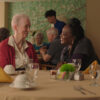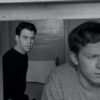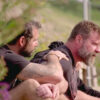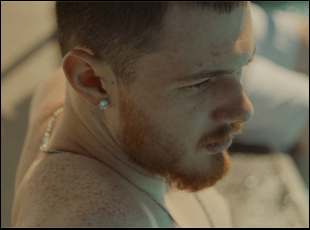“West By God” doesn’t waste time in taking your breath away, with the short opening with the striking juxtaposition of the majestic West Virginia mountains looming large over the Wild Water Express in the small town of Hinton where Nelly (Aphrodite Armstrong) is out with her friends for a day in the sun. Even though everyone can be seen relaxing by the crystal clear pool, there remains mystery behind it, and as Nelly catches her friend Fiona (Michael Armstrong) talking to Dane (Kyle Riggs), a slightly older guy than she’s used to seeing hanging around her high school, there’s a glimpse of what could be beyond the horizon. It was a feeling director Scott Lazer knew well, having been born in the area and making his return after pursuing a successful career in commercials and music videos on the East Coast, bringing with him the ability to capture life in the area without leaving much of a footprint.
“We had a pretty small crew, which allowed us to be nimble,” says Lazer, a day after the film’s world premiere at Berlinale. “That allowed us an ability to slip into the places that were already unfolding naturally like they do, giving us a lot of rich background texture that I think really filled out the scenes. I shoot a lot in New York and L.A. and a lot of times people in those places are very used to seeing films being shot in their backyard, but here, that’s not the case so much and I think people were quite excited to see that happening. It made them feel special and maybe a little proud of their town.”
The production value is impressive as Nelly and Dane roll around town on a first date, making stops at a local cafe and more secretive spots that Dane knows as a low-level drug dealer, but it’s the emotional terrain that’s covered that’s more likely to leave a mark when the two reach the edge of the New River where Dane wants to play a song special to him. With screenwriter Juli Blachowiak constructing the dialogue between the two as a delicate dance, the music moves Dane and Nelly both a few steps forward and a few steps back from one another as they sit in the car, each well aware of what the future holds if they remain where they are presently, but having entirely different reactions in terms of what to do about it. As reality sets in for the pair, the eye-catching stylistic flourishes that Lazer and crew have created with the candy-colored clothes Nelly fancies and the careful composed frames that gradually closes the gap between the two falls away for some intimate soul-baring. With the film en route to SXSW following its bow in Berlin, the director spoke about making a film that would hit close to home for both himself and anyone who sees it, as well as finding the right collaborators and developing the film’s visual language.
The film came about from a conversation between Juli Blachowiak, the screenwriter, and I. We’ve worked on a couple projects together and part of what bonded us was our mutual appreciation for hip-hop. One night, about a year ago, we were having this conversation about backpack rap and she shared this story about when she was 15 or 16 and she went out with this guy who was a few years older than her. He played her Immortal Technique in the car, and if you don’t know he is one of those very serious, thoughtful wordsmith rappers and this guy started weeping as he played it for her. I thought that was such an amazing story, I said to her, I think that’d be a good short and I was falling asleep as we were texting this. I live in New York, and she lives in L.A., a few hours behind me, so the next morning I woke up and a first draft of “West By God” was in my inbox. I was really taken by the characters and this whole journey that they go on.
That was the beginning of the process and I was born in West Virginia, so I wanted to film there for a very long time and as I was reading the script, I was just thinking about these locations that I’ve pinned in the back of my mind over the years. I was excited because the region and that area in particular has such personal relevance to me and it’s inspired me my whole life, but on top of that, it’s untapped cinematic territory. Not a lot of movies have been filmed in West Virginia in general, so I started to kind of tailor the script to that world and then we found some amazing actors, so every part of the process was just affirming we were on the right path. It was like every new step revealed this unexpected solution that excited us.
How did you find your leads for this?
I didn’t really want to cast actors from New York or L.A. I just didn’t think that would necessarily fit the vibe we were going for, and my friend Cat Lellie, who was our casting director, was finishing her MFA in producing at the University of North Carolina School for the Arts, so I sent her a script and asked if [there were] some of the student actors at UNCSA that could work for it. She hit me back and said, “Yeah, I’ve got a bunch of them in my classes. And I know Nelly. I’m going to tape her for you.” She sent the the sides to Aphrodite and we got her tape back a few days later and were just totally blown away — her expressions, the way she moves her body and emotes was totally captivating to us. She doesn’t have a whole lot of lines in the film, but it was in one of the scenes where she doesn’t have many lines, what she was doing with her face was so amazing, and it was wild because [for us] it’s like, “This is the first person we’re seeing. We’ve got to look at some other options, just for our own sake.” And we did and they were good, but they weren’t Nelly.
So we ended up going with Aphrodite and Michael Washington, who’s a student at UNCSA along with Aphrodite, and Cat knew Kyle Riggs, who played Dane, from the community of actors that she’s tapped into. He had a small part in “The Good Lord Bird,” and I think Aphrodite, Kyle and Michael all brought their own take to their roles, which rendered a very real behavior on screen, and I felt so lucky to work with them because you can have a great script, great cinematography, great production design, great locations. You can have all the aspects that go into making a great movie, but if you have duds of actors, it’s all for naught. But we had the opposite of that. In my opinion, we had some superstars. And this was Aphrodite’s first film, so to share this experience with her at a formative time in her career and her life was really special for all of us.
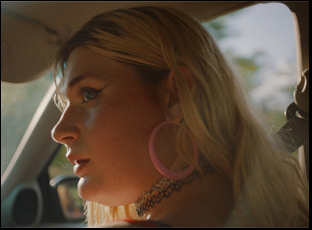
Once Aphrodite came into the mix — just looking at her [audition] tape, which was shot on her iPhone or something and still, it’s just cinematic because what she’s doing is gripping — I said to our cinematographer Taylor McIntosh, we really need to be on her face as much as possible. Obviously, we needed to get wider shots and to see the environment, but our greatest asset in terms of the composition is her face, so even in scenes where the action is not necessarily on her, we’re on her. Specifically in the beginning when Fiona and Dane are having that conversation on the other side of the pool and we’re seeing Nelly across looking at them, or later when there’s a drug deal that goes down and Dane and his customer are in the background and we’re completely out of focus, but we’re focused on [Nelly] and her discomfort in this moment, that was always going to what I knew would grab people.
In terms of the color, the film starts with this very rich warm tone and that’s meant to invoke summertime and just the richness of being young at the water park with only time ahead of you. You’ve got nothing but time, just laying around, enjoying yourself and as the film progresses, it gets colder color-wise to show the reality that sets in for both of them because on one hand, you have Nelly who is ready to just become an adult. She’s tired of being a kid, she’s not even paying attention to what her friends are talking about in the beginning. She’s got her eye set on whatever it is that’s beyond her childhood. And Dane is kind of the opposite, on the front steps of adulthood and laments not soaking up his childhood or appreciating it when he was a child, so we go from this almost hyperreality with this intense warmth of the pool and her home and then into a bit colder of a feel, a harsh reality that they both come to realize by the end of the film.
It’s interesting that the Immortal Technique was the impetus for the whole thing because when you hear the song “Dance with the Devil,” the backing track is Francis Lai’s theme from “Love Story,” so it’s that clash of the old and the new. Did that actually influence the style of the film in general?
Yeah, first of all, I should say this short is a proof of concept for a feature. We have an idea for Nelly’s journey beyond this first date she goes on with Dane, but we’re thinking of that as a period piece set in 2007/2008, and I believe Immortal is still putting music out, but “Dance with the Devil” and some of his bigger songs came out around that time, so it definitely recalls that era. I hadn’t thought of it until you asked, but it did inform the costumes and the CD case and the CD and the car – the styling of the film. We couldn’t control everything — there were a couple contemporary cars in some shots and we weren’t super strict with it, but if God willing we can make this into a feature, that’ll be something we take a lot more seriously.
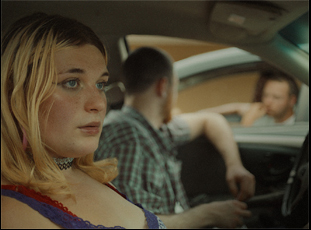
We had our premiere last night and it was a few hundred people at the House of World Cultures and it was amazing because I hadn’t seen the film on a large screen yet and I hadn’t seen it with a group — the most people I’ve seen it with is one or two people and they know me, so they’re not going to say, “Hey Scott, this sucks.” [laughs] But in a room full of strangers, several hundred of them, I was sitting next to Juli and I was so glad that people were laughing at the parts we wanted them to, [particularly] at the end of the film when you start to realize that power dynamic shift, and I was [almost] grabbing her every time it happened. It was so gratifying to know what we were doing was being interpreted as we intended.
“West By God” will screen at Berlinale on February 20th at 3 pm at CinemaxX 1 and 2. It will make its U.S. premiere at SXSW on March 12th at 2:15 pm at the Alamo Lamar B and March 16th at 12:15 pm at Alamo Lamar E.
